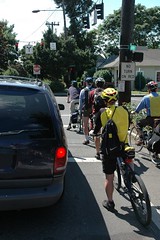
The old-school bike box at SE 39th and Clinton.
|

The colored version at SE Hawthorne and 7th.
|
The Federal Highway Administration (FHWA) has officially approved the City of Portland Office of Transportation’s (PDOT) “Request to Experiment” with green colored bike boxes on one condition; they must test their effectiveness without the green coloring many people credit with their success.
PDOT filed their Request to Experiment with the FHWA back in January. Such a request is not mandatory, but it is a required part of the process to get colored bike boxes added to the all-important Manual on Uniform Traffic Control Devices (MUTCD) — a set of guidelines used by traffic engineers across the country.
According to a statement prepared by PDOT’s head traffic engineer Rob Burchfield, Portland will comply with the FHWA’s decision. This means that three of the remaining locations pegged for bike boxes will be installed with striping and signage only, without the green color used in eight bike box intersections installed since March.
The non-colored treatments will then be evaluated “for a period of time while data is collected.” Once that data is collected, the green color will be added and another round of data will be evaluated: “This methodology is intended to help better discern the relative effectiveness of coloring the boxes as part of the overall treatment.”

From anecdotal evidence, my own observations, and from reports by the Police Bureau, it seems Portland’s bike boxes are enjoying a high rate of compliance by road users. Some folks think a major reason for that compliance is the highly visible green color. But that’s not necessarily an accurate assumption according to Richard Moeur, Chair of the MUTCD’s Bicycle Technical Committee — a volunteer group that advises the FHWA.
Moeur says he’s concerned that PDOT is testing too many new things at once (a new color, new signage, new symbols, etc…). “What you end up with,” he told me today is, “that it’s impossible to determine which device is having an effect on the traveling public.”
The problem, Moeur says, is that PDOT has “made the assumption that you need this entire package to have an effective bike box.”
“The problem is that the City of Portland has made the assumption that the color is very effective.”
— Richard Moeur, Chair of the MUTCD Bicycle Technical Committee
Moeur feels that it’s important to determine how effective each individual component is before moving forward with an official adoption. He’s also concerned that colored lanes and boxes are expensive and that not enough research has been done on how/if it significantly impacts behavior.
“Color is expensive… and there are a lot of assumptions that it will change user behavior. When it doesn’t, but you think it does, that is the big concern… I think we need more information.”
This “phased implementation approach” will begin on October 1st at the intersections of SW Terwilliger and Taylors Ferry, NW Broadway and Hoyt, and at SE 39th and Clinton (where an old bike box already exists).
Next week (8/06), PDOT will be back in front of City Council for an update on their bike box program (known officially as the Bicycle Safety: Bike Boxes and Alternatives Report to Council).
Since launching their bike box campaign in October of 2007 (in the wake of two fatal crashes that involved right-turning motor vehicles), PDOT has painted eight intersections with bike boxes. Of the 14 original intersections identified, one is delayed and three have been removed from consideration for the treatment for various reasons*.
See all of BikePortland.org’s bike box coverage here.
*At the request of a commenter below, here are the three intersections that are no longer being considered for the bike box treatment (as per PDOT):
- N Interstate at Greeley (after further analysis and public involvement closure of the right turn is recommended)
- NE Broadway at Williams (after further analysis the geometry of this intersection precludes effective use of the bike box at this location)
- NW Lovejoy at 9th Ave (delayed due pending design and construction of the streetcar extension project)


